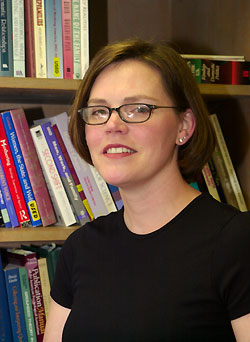|
This is an archived article.
For the latest news, go to the
Advance Homepage
For more archives, go to the Advance Archive/Search Page. | ||
|
Researcher Studying How The challenges of marriage are a field of study unto itself. But the complexities of uniting two families under one roof in remarriage - a system of relationships known commonly as step-families - have been little studied.
One researcher compared the early period of being a step-mother to "setting up a family on an ice floe." To Shannon Weaver, an assistant professor of family studies who studies the dynamics of step-families, the metaphor seems apt. Weaver's studies draw her not to the ice floe, but to the methods and practices remarried families use to build stability - stepping off the ice floe onto firm footing. "My interest is in family dynamics," Weaver says. "I want to find out what works, not what's the problem." Weaver, who earned her Ph.D. in 2000, is conducting qualitative research on role construction and relationship formation by women in step-families. She says communication is the single most important ingredient in a family. Her studies have taken her to the heart of several families. Over a period of four years. she has followed them through good times and bad, successes and failures, unique circumstances and common experiences. "Step-families are complex and come in many forms," Weaver says. The possible combinations of children from two or more families, their ages and order, and which parents are biological and which are stepparents are just the beginning. "We don't have well-defined roles for remarriage," Weaver says. Yet some patterns have emerged. She says that when women remarry they often engage in protective behaviors, and she has identified a number of typical roles:
Critically important to success, says Weaver, is "figuring out what you can control, and accepting what you can't. Flexibility is important in every family form, but particularly in step-families." She says that an idealized form of imagined family structure, often called "a real family," cropped up periodically as a goal among the families she studied. The "real family" is supposed to be conflict-free. Problems arise when an actual family does not match up to this impossible standard. "You don't have to be the Brady Bunch," says Weaver, "and in most cases, you shouldn't be." The Brady Bunch ideal, though not often specifically cited by family members, illustrates an important point in the American understanding of step-family dynamics. In anything from the tales of Snow White and Cinderella to movies and television, step-families in general and step-mothers in particular are portrayed negatively. Step-mothers find themselves in a particular dilemma because, Weaver says, "you can't be a mother, but you must do things that are mothering." She says some step-mothers see their role like that of a big sister. "The step-mother makes sure the children are fed, clothed, and have what they need," she says, including birthday cards and gifts, but at the same time, "they do not want to infringe on the (biological) mother's territory." Weaver earned her bachelor's, master's and Ph.D. degrees from the University of Missouri-Columbia. Originally a nursing major, she began studying step-families as an undergraduate after taking a required course in family studies. She saw connections in her own extended family's experiences, and found connections in those of others. A new mother, Weaver says she has gained a new perspective on the field now she has a child of her own. |

